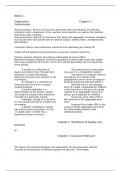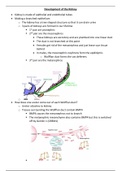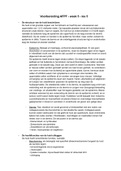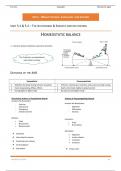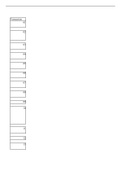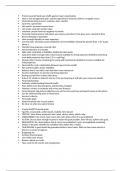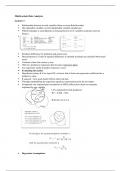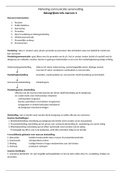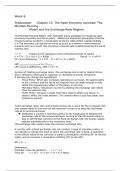Week 1 :
Preparation: Chapter 1 :
Preliminaries
Microeconomics: Branch of economics that deals with the behavior of individual
economic units—consumers, firms, workers, and investors—as well as the markets
that these units comprise.
Macroeconomics: Branch of economics that deals with aggregate economic variables,
such as the level and growth rate of national output, interest rates, unemployment,
and inflation.
Consumer theory: how consumers maximize their well-being by trading off.
Trades off are based on prices faced by consumers, workers and firms.
Positive analysis: Analysis describing relationships of cause/ effect.
Normative analysis: Analysis examining questions of what ought to be/ also added
with value judgments (if involve: micro can’t tell the best policy but can illuminate
some points).
A market is a collection of The market price is prevailing
buyers and sellers that, through their (dominant) in a competitive market
potential or actual interactions, The extent of a market refers to
determine the price of a product or set boundaries of a market, both
of products. geographical and in terms of range of
An industry is a collection of products produced and sold within it.
firms that sell the same or closely Nominal price is the absolute
related products. price of a good, unadjusted for inflation
A market definition is a ≠ the real price is the price of a good
determination of the buyers, sellers, relative to an aggregate measure of
and range of products that should be prices; price adjusted for inflation.
included in a particular market. Consumer price index (CPI) is
Arbitrage: buying at a low price the measure of the aggregate price
on one market and sell at a higher one level.
on another. Producer Price Index (PPI) is the
A perfect competitive market measure of the aggregate price level
has many buyers and sellers, so that for intermediate products and
no single buyer or seller has a wholesale goods.
significant impact on prices.
Chapter 2: The Basics of Supply and
Demand
sh
Chapter 3: Consumer Behavior
The theory of consumer behavior: the explanation of how consumers allocate
incomes to the purchase of different goods and services. Three steps:
Preparation: Chapter 1 :
Preliminaries
Microeconomics: Branch of economics that deals with the behavior of individual
economic units—consumers, firms, workers, and investors—as well as the markets
that these units comprise.
Macroeconomics: Branch of economics that deals with aggregate economic variables,
such as the level and growth rate of national output, interest rates, unemployment,
and inflation.
Consumer theory: how consumers maximize their well-being by trading off.
Trades off are based on prices faced by consumers, workers and firms.
Positive analysis: Analysis describing relationships of cause/ effect.
Normative analysis: Analysis examining questions of what ought to be/ also added
with value judgments (if involve: micro can’t tell the best policy but can illuminate
some points).
A market is a collection of The market price is prevailing
buyers and sellers that, through their (dominant) in a competitive market
potential or actual interactions, The extent of a market refers to
determine the price of a product or set boundaries of a market, both
of products. geographical and in terms of range of
An industry is a collection of products produced and sold within it.
firms that sell the same or closely Nominal price is the absolute
related products. price of a good, unadjusted for inflation
A market definition is a ≠ the real price is the price of a good
determination of the buyers, sellers, relative to an aggregate measure of
and range of products that should be prices; price adjusted for inflation.
included in a particular market. Consumer price index (CPI) is
Arbitrage: buying at a low price the measure of the aggregate price
on one market and sell at a higher one level.
on another. Producer Price Index (PPI) is the
A perfect competitive market measure of the aggregate price level
has many buyers and sellers, so that for intermediate products and
no single buyer or seller has a wholesale goods.
significant impact on prices.
Chapter 2: The Basics of Supply and
Demand
sh
Chapter 3: Consumer Behavior
The theory of consumer behavior: the explanation of how consumers allocate
incomes to the purchase of different goods and services. Three steps:

